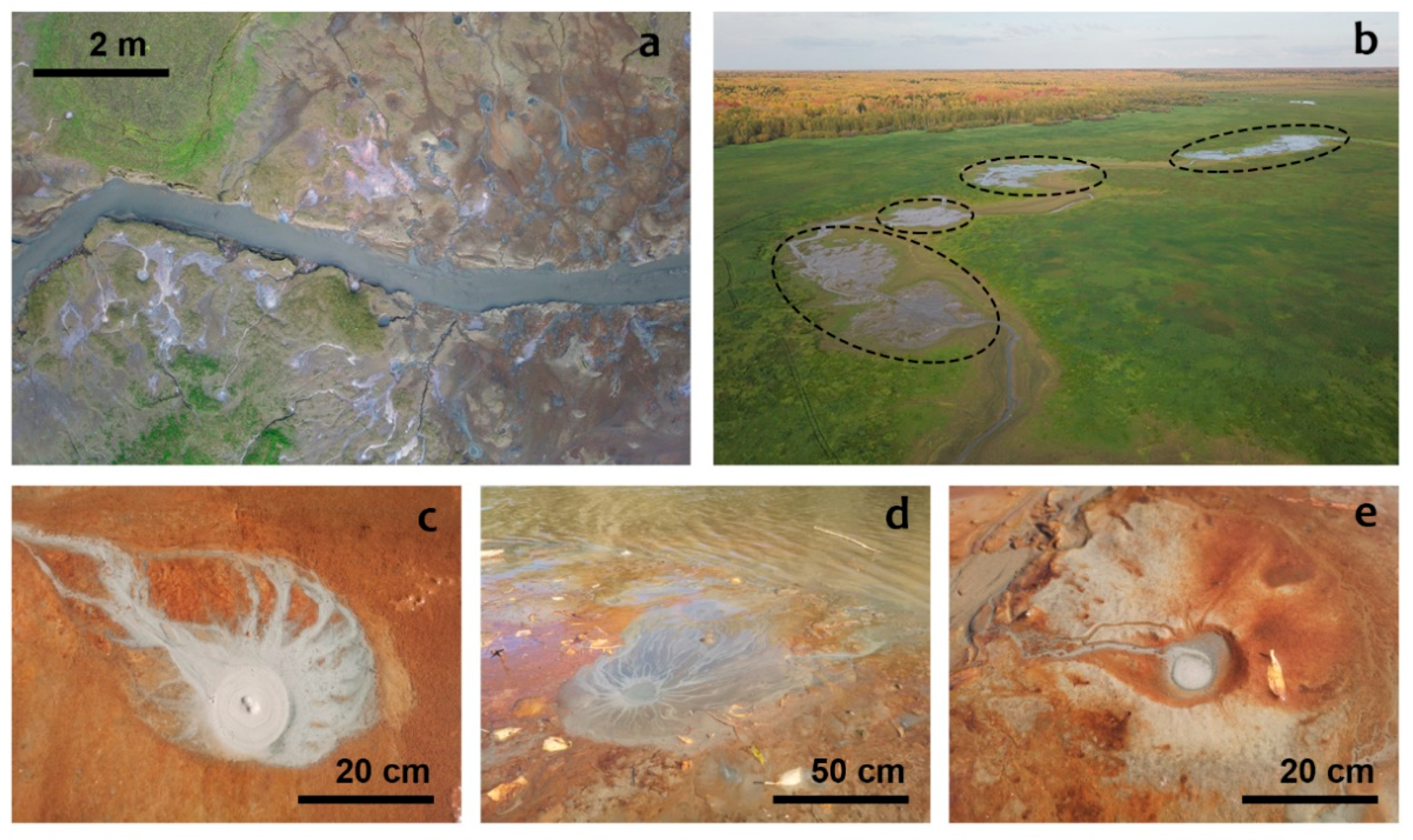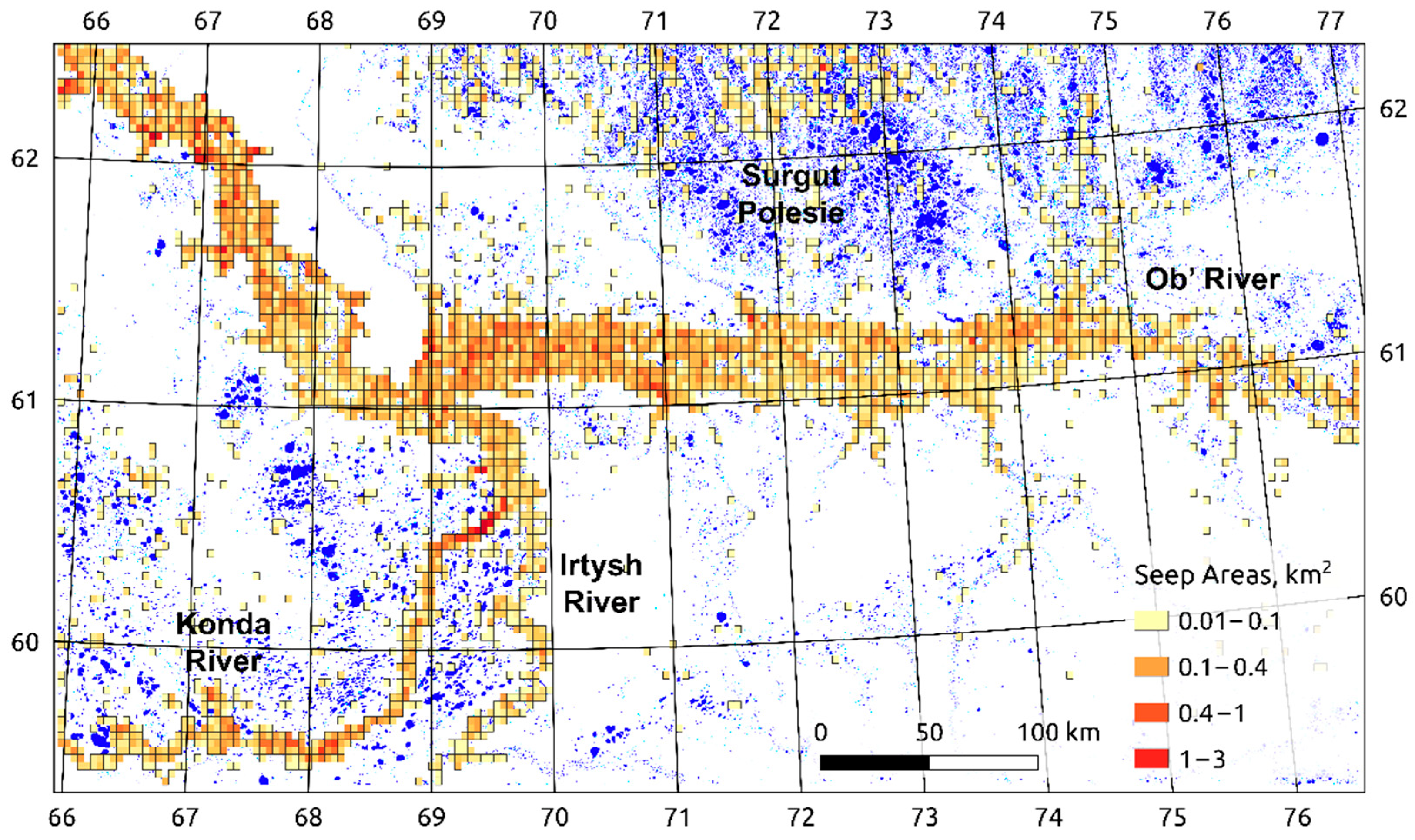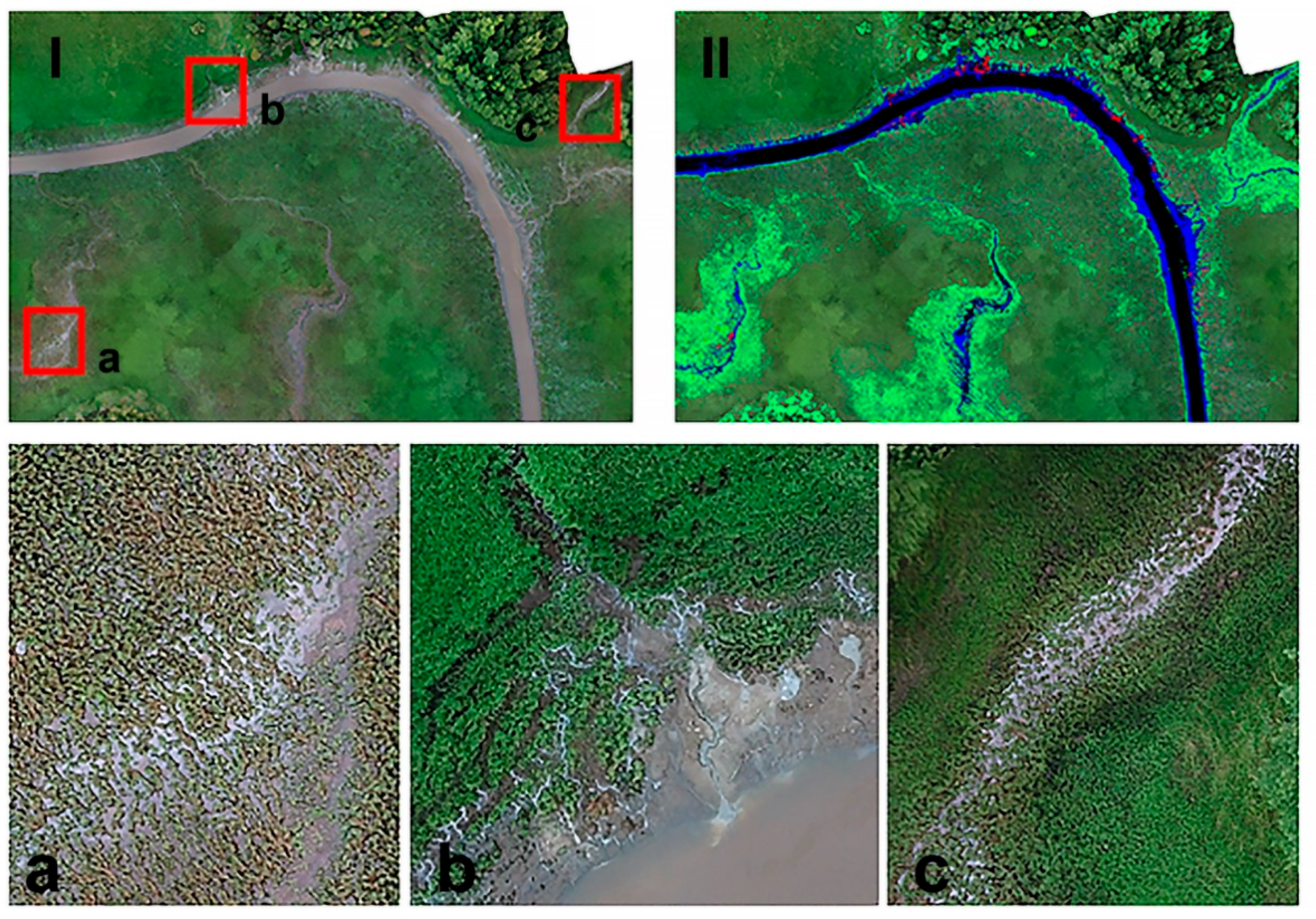Mapping Onshore CH4 Seeps in Western Siberian Floodplains Using Convolutional Neural Network
Abstract
:1. Introduction
2. Materials and Methods
2.1. Study Area
- Seeps: individual fine-scale holes and craters (up to 50 cm) with an active release of gas bubbles, seeps can be detected only using UAV images or in the field (Figure 1c–e);
- Seep abundance areas: areas of numerous seeps with a bare waterlogged soil in between, such areas can be easily detected using UAV (Figure 1a);
- Seep-affected areas: surrounding waterlogged areas obscured by a floodplain vegetation (with no visible seeps), they can be detected in the field only and might be a strong source of CH4;
- Seep areas: a mixed class that is used for mapping by a satellite imagery; it represents all abovementioned types in combination with open water (usually, river channel) and floodplain vegetation.
2.2. Mapping Seep Fields
2.2.1. Satellite Imagery
2.2.2. Mapping Seep Areas using Sentinel-2
- Open water class includes all water bodies that are widespread within the studied region: river channels, lakes, and ponds within bogs, floodplains, and uplands;
- Seep areas include mixed pixels with high coverage of seeps in combination with open water and floodplain vegetation.
- Other class includes non-target areas such as bogs, forests, floodplains, etc.
2.2.3. Seep Mapping using UAV
3. Results
3.1. Seep Area Mapping
3.2. RF and CNN Comparison
3.3. Mapping Seep Areas with UAV
4. Discussion
4.1. Seep Areas in Western Siberia
4.2. Seeps and Microseepage: Effect on Regional Flux
4.3. Seasonal Changes in Seep Areas
4.4. Limitations
5. Conclusions
Supplementary Materials
Author Contributions
Funding
Data Availability Statement
Conflicts of Interest
References
- Krickov, I.V.; Serikova, S.; Pokrovsky, O.S.; Vorobyev, S.N.; Lim, A.G.; Siewert, M.B.; Karlsson, J. Sizable carbon emission from the floodplain of Ob River. Ecol. Indic. 2021, 131, 108164. [Google Scholar] [CrossRef]
- Terentieva, I.; Sabrekov, A.; Ilyasov, D.; Ebrahimi, A.; Glagolev, M.; Maksyutov, S. Highly dynamic methane emission from the West Siberian boreal floodplains. Wetlands 2019, 39, 217–226. [Google Scholar] [CrossRef]
- Saunois, M.; Stavert, A.R.; Poulter, B.; Bousquet, P.; Canadell, J.G.; Jackson, R.B.; Raymond, P.A.; Dlugokencky, E.J.; Houweling, S.; Patra, P.K. The global methane budget 2000–2017. Earth Syst. Sci. Data 2020, 12, 1561–1623. [Google Scholar] [CrossRef]
- Canadell, J.G.; Monteiro, P.M.; Costa, M.H.; Da Cunha, L.C.; Cox, P.M.; Alexey, V.; Henson, S.; Ishii, M.; Jaccard, S.; Koven, C. Global Carbon and Other Biogeochemical Cycles and Feedbacks; OceanRep: Kiel, Germany, 2021. [Google Scholar]
- Oshkin, I.Y.; Wegner, C.E.; Luke, C.; Glagolev, M.V.; Filippov, I.V.; Pimenov, N.V.; Liesack, W.; Dedysh, S.N. Gammaproteobacterial methanotrophs dominate cold methane seeps in floodplains of West Siberian rivers. Appl. Environ. Microbiol. 2014, 80, 5944–5954. [Google Scholar] [CrossRef] [PubMed] [Green Version]
- Sabrekov, A.; Terentieva, I.; Litti, Y.; Glagolev, M.; Filippov, I. Methane emission from seeps of West Siberian middle taiga river floodplains. In Proceedings of the 23rd EGU General Assembly, Online, 19–30 April 2021; p. EGU21-480. [Google Scholar]
- Milkov, A.V. Methanogenic biodegradation of petroleum in the West Siberian Basin (Russia): Significance for formation of giant Cenomanian gas pools. AAPG Bull. 2010, 94, 1485–1541. [Google Scholar] [CrossRef]
- Ulmishek, G.F. Petroleum Geology and Resources of the West Siberian Basin, Russia; US Department of the Interior, US Geological Survey Reston: Reston, VA, USA, 2003. [Google Scholar]
- Ciotoli, G.; Procesi, M.; Etiope, G.; Fracassi, U.; Ventura, G. Influence of tectonics on global scale distribution of geological methane emissions. Nat. Commun. 2020, 11, 2305. [Google Scholar] [CrossRef]
- Etiope, G.; Ciotoli, G.; Schwietzke, S.; Schoell, M. Gridded maps of geological methane emissions and their isotopic signature. Earth Syst. Sci. Data 2019, 11, 1–22. [Google Scholar] [CrossRef] [Green Version]
- Terentieva, I.E.; Glagolev, M.V.; Lapshina, E.D.; Sabrekov, A.F.; Maksyutov, S. Mapping of West Siberian taiga wetland complexes using Landsat imagery: Implications for methane emissions. Biogeosciences 2016, 13, 4615–4626. [Google Scholar] [CrossRef] [Green Version]
- Glagolev, M.; Kleptsova, I.; Filippov, I.; Maksyutov, S.; Machida, T. Regional methane emission from West Siberia mire landscapes. Environ. Res. Lett. 2011, 6, 045214. [Google Scholar] [CrossRef]
- Kim, H.S.; Maksyutov, S.; Glagolev, M.V.; Machida, T.; Patra, P.K.; Sudo, K.; Inoue, G. Evaluation of methane emissions from West Siberian wetlands based on inverse modeling. Environ. Res. Lett. 2011, 6, 035201. [Google Scholar] [CrossRef] [Green Version]
- Bohn, T.J.; Lettenmaier, D.P. Exploring the response of West Siberian wetland methane emissions to future changes in climate, vegetation, and soil microbial communities. Biogeosci. Discuss. 2013, 10, 16329–16369. [Google Scholar] [CrossRef]
- Sheng, Y.; Smith, L.C.; MacDonald, G.M.; Kremenetski, K.V.; Frey, K.E.; Velichko, A.A.; Lee, M.; Beilman, D.W.; Dubinin, P. A high-resolution GIS-based inventory of the west Siberian peat carbon pool. Glob. Biogeochem. Cycles 2004, 18, GB3004. [Google Scholar] [CrossRef]
- Peregon, A.; Yamagata, Y. The use of ALOS/PALSAR backscatter to estimate above-ground forest biomass: A case study in Western Siberia. Remote Sens. Environ. 2013, 137, 139–146. [Google Scholar] [CrossRef]
- Bohn, T.J.; Melton, J.R.; Ito, A.; Kleinen, T.; Spahni, R.; Stocker, B.D.; Zhang, B.; Zhu, X.; Schroeder, R.; Glagolev, M.V.; et al. WETCHIMP-WSL: Intercomparison of wetland methane emissions models over West Siberia. Biogeosciences 2015, 12, 3321–3349. [Google Scholar] [CrossRef] [Green Version]
- Zhang, Z.; Fluet-Chouinard, E.; Jensen, K.; McDonald, K.; Hugelius, G.; Gumbricht, T.; Carroll, M.; Prigent, C.; Bartsch, A.; Poulter, B. Development of the global dataset of Wetland Area and Dynamics for Methane Modeling (WAD2M). Earth Syst. Sci. Data 2021, 13, 2001–2023. [Google Scholar] [CrossRef]
- Kuhn, M.A.; Varner, R.K.; Bastviken, D.; Crill, P.; MacIntyre, S.; Turetsky, M.; Walter Anthony, K.; McGuire, A.D.; Olefeldt, D. BAWLD-CH 4: A Comprehensive Dataset of Methane Fluxes from Boreal and Arctic Ecosystems. Earth Syst. Sci. Data Discuss. 2021, 13, 5151–5189. [Google Scholar] [CrossRef]
- Sabrekov, A.F.; Glagolev, M.; Alekseychik, P.; Smolentsev, B.; Terentieva, I.; Krivenok, L.; Maksyutov, S. A process-based model of methane consumption by upland soils. Environ. Res. Lett. 2016, 11, 075001. [Google Scholar] [CrossRef]
- Sabrekov, A.F.; Danilova, O.V.; Terentieva, I.E.; Ivanova, A.A.; Belova, S.E.; Litti, Y.V.; Glagolev, M.V.; Dedysh, S.N. Atmospheric Methane Consumption and Methanotroph Communities in West Siberian Boreal Upland Forest Ecosystems. Forests 2021, 12, 1738. [Google Scholar] [CrossRef]
- Ronneberger, O.; Fischer, P.; Brox, T. U-net: Convolutional networks for biomedical image segmentation. In Proceedings of the International Conference on Medical Image Computing and Computer-Assisted Intervention, Munich, Germany, 5–9 October 2015; pp. 234–241. [Google Scholar]
- Krizhevsky, A.; Sutskever, I.; Hinton, G.E. Imagenet classification with deep convolutional neural networks. Adv. Neural Inf. Process. Syst. 2012, 25, 84–90. [Google Scholar] [CrossRef]
- LeCun, Y.; Bengio, Y.; Hinton, G. Deep learning. Nature 2015, 521, 436–444. [Google Scholar] [CrossRef]
- Danilova, O.; Ivanova, A.; Terent’eva, I.; Glagolev, M.; Sabrekov, A. Microbial Community Composition of Floodplains Shallow-Water Seeps in the Bolshaya Rechka Floodplain, Western Siberia. Microbiology 2021, 90, 632–642. [Google Scholar] [CrossRef]
- Dyukarev, E.; Filippova, N.; Karpov, D.; Shnyrev, N.; Zarov, E.; Filippov, I.; Voropay, N.; Avilov, V.; Artamonov, A.; Lapshina, E. Hydrometeorological dataset of West Siberian boreal peatland: A 10-year record from the Mukhrino field station. Earth Syst. Sci. Data 2021, 13, 2595–2605. [Google Scholar] [CrossRef]
- Gorelick, N.; Hancher, M.; Dixon, M.; Ilyushchenko, S.; Thau, D.; Moore, R. Google Earth Engine: Planetary-scale geospatial analysis for everyone. Remote Sens. Environ. 2017, 202, 18–27. [Google Scholar] [CrossRef]
- Wu, Q. geemap: A Python package for interactive mapping with Google Earth Engine. J. Open Source Softw. 2020, 5, 2305. [Google Scholar] [CrossRef]
- Van Rossum, G.; Drake, F.L., Jr. Python Tutorial; Centrum voor Wiskunde en Informatica: Amsterdam, The Netherlands, 1995; Volume 620. [Google Scholar]
- QGIS Association. QGIS Geographic Information System; QGIS Association: Zürich, Switzerland, 2021. [Google Scholar]
- Ho, T.K. Random decision forests. In Proceedings of the 3rd International Conference on Document Analysis and Recognition, Montreal, QC, Canada, 14–15 August 1995; pp. 278–282. [Google Scholar]
- Du, Y.; Zhang, Y.; Ling, F.; Wang, Q.; Li, W.; Li, X. Water bodies’ mapping from Sentinel-2 imagery with modified normalized difference water index at 10-m spatial resolution produced by sharpening the SWIR band. Remote Sens. 2016, 8, 354. [Google Scholar] [CrossRef] [Green Version]
- Wang, Z.; Liu, J.; Li, J.; Zhang, D.D. Multi-spectral water index (MuWI): A native 10-m multi-spectral water index for accurate water mapping on Sentinel-2. Remote Sens. 2018, 10, 1643. [Google Scholar] [CrossRef] [Green Version]
- Palmer, S.C.J.; Kutser, T.; Hunter, P.D. Remote sensing of inland waters: Challenges, progress and future directions. Remote Sens. Environ. 2015, 157, 1–8. [Google Scholar] [CrossRef] [Green Version]
- Sheykhmousa, M.; Mahdianpari, M.; Ghanbari, H.; Mohammadimanesh, F.; Ghamisi, P.; Homayouni, S. Support vector machine versus random forest for remote sensing image classification: A meta-analysis and systematic review. IEEE J. Sel. Top. Appl. Earth Obs. Remote Sens. 2020, 13, 6308–6325. [Google Scholar] [CrossRef]
- Alom, M.Z.; Hasan, M.; Yakopcic, C.; Taha, T.M.; Asari, V.K. Recurrent residual convolutional neural network based on u-net (r2u-net) for medical image segmentation. arXiv 2018, arXiv:1802.06955. [Google Scholar]
- He, K.; Zhang, X.; Ren, S.; Sun, J. Deep residual learning for image recognition. In Proceedings of the IEEE Conference on Computer Vision and Pattern Recognition, San Juan, PR, USA, 19–24 June 2016; pp. 770–778. [Google Scholar]
- Ghorbanzadeh, O.; Crivellari, A.; Ghamisi, P.; Shahabi, H.; Blaschke, T. A comprehensive transferability evaluation of U-Net and ResU-Net for landslide detection from Sentinel-2 data (case study areas from Taiwan, China, and Japan). Sci. Rep. 2021, 11, 14629. [Google Scholar] [CrossRef]
- Dang, K.B.; Nguyen, M.H.; Nguyen, D.A.; Phan, T.T.H.; Giang, T.L.; Pham, H.H.; Nguyen, T.N.; Tran, T.T.V.; Bui, D.T. Coastal wetland classification with deep U-Net convolutional networks and Sentinel-2 imagery: A case study at the Tien Yen estuary of Vietnam. Remote Sens. 2020, 12, 3270. [Google Scholar] [CrossRef]
- Torres, D.L.; Turnes, J.N.; Soto Vega, P.J.; Feitosa, R.Q.; Silva, D.E.; Marcato Junior, J.; Almeida, C. Deforestation Detection with Fully Convolutional Networks in the Amazon Forest from Landsat-8 and Sentinel-2 Images. Remote Sens. 2021, 13, 5084. [Google Scholar] [CrossRef]
- Zhang, Z.; Liu, Q.; Wang, Y. Road extraction by deep residual u-net. IEEE Geosci. Remote Sens. Lett. 2018, 15, 749–753. [Google Scholar] [CrossRef] [Green Version]
- Kingma, D.P.; Ba, J. Adam: A method for stochastic optimization. arXiv 2014, arXiv:1412.6980. [Google Scholar]
- Lin, T.-Y.; Goyal, P.; Girshick, R.; He, K.; Dollár, P. Focal loss for dense object detection. In Proceedings of the IEEE International Conference on Computer Vision, Venice, Italy, 22–29 October 2017; pp. 2980–2988. [Google Scholar]
- Virtanen, P.; Gommers, R.; Oliphant, T.E.; Haberland, M.; Reddy, T.; Cournapeau, D.; Burovski, E.; Peterson, P.; Weckesser, W.; Bright, J. SciPy 1.0: Fundamental algorithms for scientific computing in Python. Nat. Methods 2020, 17, 261–272. [Google Scholar] [CrossRef] [Green Version]
- Congalton, R.G.; Green, K. Assessing the Accuracy of Remotely Sensed Data: Principles and Practices; CRC Press: Boca Raton, FL, USA, 2008. [Google Scholar]
- Buitinck, L.; Louppe, G.; Blondel, M.; Pedregosa, F.; Mueller, A.; Grisel, O.; Niculae, V.; Prettenhofer, P.; Gramfort, A.; Grobler, J. API design for machine learning software: Experiences from the scikit-learn project. arXiv 2013, arXiv:1309.0238. [Google Scholar]
- Arganda-Carreras, I.; Kaynig, V.; Rueden, C.; Eliceiri, K.W.; Schindelin, J.; Cardona, A.; Sebastian Seung, H. Trainable Weka Segmentation: A machine learning tool for microscopy pixel classification. Bioinformatics 2017, 33, 2424–2426. [Google Scholar] [CrossRef]
- Klaus, M.; Vachon, D. Challenges of predicting gas transfer velocity from wind measurements over global lakes. Aquat. Sci. 2020, 82, 53. [Google Scholar] [CrossRef]
- Dlugokencky, E.J.; Nisbet, E.G.; Fisher, R.; Lowry, D. Global atmospheric methane: Budget, changes and dangers. Philos. Trans. R. Soc. A Math. Phys. Eng. Sci. 2011, 369, 2058–2072. [Google Scholar] [CrossRef] [Green Version]
- Etiope, G.; Schwietzke, S.; Helmig, D.; Palmer, P. Global geological methane emissions: An update of top-down and bottom-up estimates. Elem. Sci. Anthr. 2019, 7, 47. [Google Scholar] [CrossRef] [Green Version]
- Sabrekov, A.F.; Runkle, B.R.; Glagolev, M.V.; Terentieva, I.E.; Stepanenko, V.M.; Kotsyurbenko, O.R.; Maksyutov, S.S.; Pokrovsky, O.S. Variability in methane emissions from West Siberia’s shallow boreal lakes on a regional scale and its environmental controls. Biogeosciences 2017, 14, 3715–3742. [Google Scholar] [CrossRef] [Green Version]






| Target Class | Precision | Recall | F1-Score | OA 1 | Kappa | |
|---|---|---|---|---|---|---|
| CNN | ||||||
| Others | 0.65 | 0.98 | 0.79 | 86.1% | 78.7% | |
| Seep Areas | 0.90 | 0.79 | 0.84 | |||
| Open Water | 0.98 | 0.87 | 0.92 | |||
| Random Forest | ||||||
| Others | 0.39 | 0.99 | 0.88 | 65.7% | 50.1% | |
| Seep Areas | 0.89 | 0.42 | 0.57 | |||
| Open Water | 0.90 | 0.76 | 0.82 | |||
Publisher’s Note: MDPI stays neutral with regard to jurisdictional claims in published maps and institutional affiliations. |
© 2022 by the authors. Licensee MDPI, Basel, Switzerland. This article is an open access article distributed under the terms and conditions of the Creative Commons Attribution (CC BY) license (https://creativecommons.org/licenses/by/4.0/).
Share and Cite
Terentieva, I.; Filippov, I.; Sabrekov, A.; Glagolev, M. Mapping Onshore CH4 Seeps in Western Siberian Floodplains Using Convolutional Neural Network. Remote Sens. 2022, 14, 2661. https://doi.org/10.3390/rs14112661
Terentieva I, Filippov I, Sabrekov A, Glagolev M. Mapping Onshore CH4 Seeps in Western Siberian Floodplains Using Convolutional Neural Network. Remote Sensing. 2022; 14(11):2661. https://doi.org/10.3390/rs14112661
Chicago/Turabian StyleTerentieva, Irina, Ilya Filippov, Aleksandr Sabrekov, and Mikhail Glagolev. 2022. "Mapping Onshore CH4 Seeps in Western Siberian Floodplains Using Convolutional Neural Network" Remote Sensing 14, no. 11: 2661. https://doi.org/10.3390/rs14112661
APA StyleTerentieva, I., Filippov, I., Sabrekov, A., & Glagolev, M. (2022). Mapping Onshore CH4 Seeps in Western Siberian Floodplains Using Convolutional Neural Network. Remote Sensing, 14(11), 2661. https://doi.org/10.3390/rs14112661






